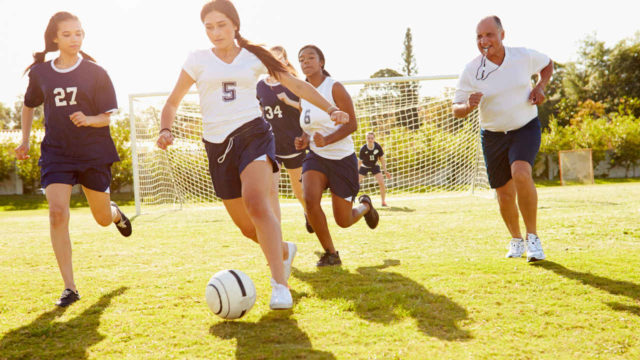 These tips will help you recognize and respond to possible brain injuries.
These tips will help you recognize and respond to possible brain injuries.
As concern about concussions among young athletes grows, experts increasingly urge coaches, parents, and athletes to learn how to recognize and respond to a concussion. And with good reason – sports-related concussions account for more than half of all emergency room visits in children ages 8-13.
The decisions made after a young athlete sustains a possible head injury can make a difference in whether the athlete fully recovers. A child who has a concussion is 1½ times more likely to have another. If they have had 2 concussions, they have 3 times the risk of it happening again.
“A concussion happens when a blow to the head or an injury makes the head move back and forth with a lot of force. This causes chemical changes in the brain and sometimes damage to the brain cells. Kids and teens who follow their health care provider’s recommendations usually feel better within a few weeks of the concussion.“
Signs of possible concussion include:
- Loss of consciousness
- Headache
- Blurry or double vision
- Nausea or vomiting
- Dizziness or balance problems
- Sensitivity to noise or light
- Difficulty concentrating or remembering new information
- Confusion
- Irritability or nervousness
- Moodiness or sadness
- Excessive sleepiness or sluggishness
- Difficulty falling or staying asleep
Some signs of a concussion may appear right away, but others may not show up until hours or days after injury.
What to do if you think an athlete has a concussion:
- Remove the athlete from play or practice on the day of injury. When in doubt, have them sit it out.
- Seek medical attention. Only a health care provider can determine if an athlete has a concussion and when it’s okay to return to play. A quick concussion test on the sidelines is not enough.
Other facts about concussion:
- Concussions are not limited to male athletes. In fact, studies show that female athletes sustain a higher percentage of concussions during games than male athletes.
- Sports particularly susceptible to concussions include soccer, football, lacrosse, ice hockey, basketball, wrestling and gymnastics.
- You don’t have to get hit on the head to have a concussion. Bodily contact can also cause injury to your brain.
Copyright 2018-2020 © Baldwin Publishing, Inc. All rights reserved.
Health eCooking® is a registered trademark of Baldwin Publishing, Inc. Cook eKitchen™ is a designated trademark of Baldwin Publishing, Inc. Any duplication or distribution of the information contained herein without the express approval of Baldwin Publishing, Inc. is strictly prohibited.
Date Last Reviewed: January 16, 2020
Editorial Review: Andrea Cohen, Editorial Director, Baldwin Publishing, Inc. Contact Editor
Medical Review: Perry Pitkow, MD
Learn more about Baldwin Publishing Inc. editorial policy, privacy policy, ADA compliance and sponsorship policy.
No information provided by Baldwin Publishing, Inc. in any article is a substitute for medical advice or treatment for any medical condition. Baldwin Publishing, Inc. strongly suggests that you use this information in consultation with your doctor or other health professional. Use or viewing of any Baldwin Publishing, Inc. article signifies your understanding and agreement to the disclaimer and acceptance of these terms of use.